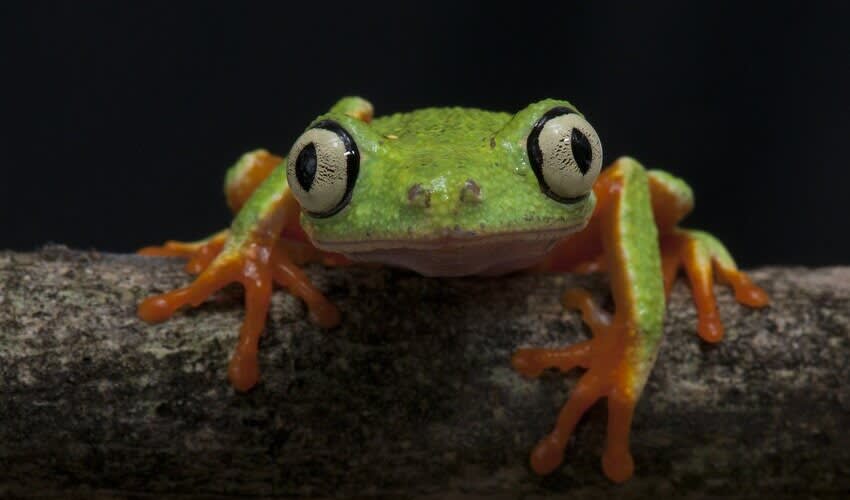Anura – Frogs
Toads are kind of frogs, with shorter legs (to crawl & hop rather than leap) and dry skin (and not moist like frogs)
The word amphibian is almost synonymous with frogs and toads.
This largest order of amphibians is instantly recognizable with their short, rigid bodies and distinct lack of a tail. They have large eyes and a keen sense of smell that they use to catch their prey by flicking out their long, sticky tongues. Females are typically larger than males. Their skin varies greatly; some frogs have skin so thin that you can view their internal organs, while the skin of some toads has been substituted for leather!
They also exhibit a wide range of sizes, from the minuscule Brazilian gold frog to the gigantic Goliath frog. Some frogs possess transparent lower eyelids, allowing them to see underwater while staying protected. Notably, certain species can change their skin color based on temperature, light, and mood, adding to their unique charm.
Beyond biology, frogs are culturally significant symbols, representing transformation, renewal, rain, and fertility in various societies. They embody personal growth, resilience, and the cyclical nature of life due to their unique life cycle. Additionally, they are associated with the life-giving power of rain and are believed to bring fertility and abundance to those seeking it, making them multifaceted icons in human culture.
Families in this order
Despite they name, this family include a diversity of frog species, many of which are terrestrial or semiaquatic
Also known as “moss frogs” or “bush frogs”, some members of this family are “flying frogs” or “gliding frogs”
These small plump frogs with triangular-shaped body and a pointed snout are geographically widespread
Only family of anurans in which all members are known as toads: rough skinned, squat-bodied & short-legged
Widest distributed of any amphibian, these “classic” frogs have a typical smooth skin, webbed feet & large, powerful legs
Their horns are not true horns but are extensions of the skin that help enhance their camouflage
Also called “rubber frogs” due to their smooth, rubbery skin, which lacks granular glands
Some species have developed a remarkable resistance to the toxins in the insects they consume
Most species displays smooth and vibrant patterns that resemble enamel
Versatile frogs of the Old World
Sister group to the leaf frogs; considered by some as a group them within family Hylidae
In some regions, particularly in South America, certain species are harvested for food, while others play roles in local folklore and traditional medicine
Native to tropical Central & South America; bright and colorful as they may be, these infamous frogs deserve your respect!
Fancy transparency? Bones, internal organs & a beating heart can be seen through the translucent skin!
Long-fingered frogs, Night frogs, Egg frogs, a Hairy frog, Forest treefrogs and what not!
Native to Central and South America, this family is sister group of poison dart frogs, but are not as toxic
Unlike your typical frog, these New World frogs don’t have a tadpole stage!
Their cryptic coloration allows them to blend seamlessly into their surroundings
Like kangaroos, carry their young in pouches —on their backs
They’ll eat almost anything they can fit in their mouths, including insects, rodents, reptiles, small birds, and even other frogs
Among the first frogs you’ll hear after a heavy downpour
True to their name, members in this family resemble leaves in both color and shape
Unlike their web-footed cousins who chill by the water, these guys are built for adventure on Australia’s often dry soil
Unlike most frogs that have long, strong legs for jumping, they have shorter, paddle-like legs perfect for swimming
Often described as “angry marshmallows” or “grumpy potatoes with legs”
Male frogs of this family carry a string of fertilized eggs on their backs, making them commonly known as “midwife frogs”
Toads native to Eurasia, characterized with flattened bodies. Some species are highly toxic!
Sub-Saharan frog giants that are commonly known as ‘slippery frogs’
Tadpoles have mouthparts that function like suckers, allowing them to attach firmly to rocks in fast-flowing streams
Diggin into sandy soil, members of this family spend much of their life in the ground
Their unique skin texture that resembles the look of parsley, hence the name
Their tadpoles are among the fastest-developing amphibians in the world—a crucial trait in temporary desert pools
Its color comes from a pigment called melanin, which is also found in human skin


































